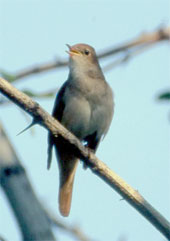|

Just the Facts: The Nightingale is similar in size to the European Robin, at 15-16.5 cm length. It is plain brown above except for the red-sided tail with red side patches. It is buff to white below. Sexes are similar. Eastern races have paler upperparts and a stronger face-pattern, including a pale supercilium.

 Range and Migration: It is a migratory insectivorous species breeding in forest and scrub in Europe and south-west Asia. The distribution is more southerly than the very closely related Thrush Nightingale Luscinia luscinia. It nests low in dense bushes. It winters in southern Africa. Range and Migration: It is a migratory insectivorous species breeding in forest and scrub in Europe and south-west Asia. The distribution is more southerly than the very closely related Thrush Nightingale Luscinia luscinia. It nests low in dense bushes. It winters in southern Africa.
Sing Sweet Nightengale: The male Nightingale is known for his singing, to the extent that human singers are sometimes admiringly referred to as nightingales; the birdsong is loud, with an impressive range of whistles, trills and gurgles. Although it also sings during the day, the nightingale is unusual in singing late in the evening; its song is particularly noticeable at that time because few other birds are singing. This is why its name (in several languages) includes "night".
City Song: Recent research has shown that the birds sing even more loudly in
urban or near-urban environments, in order to overcome the background noise.
The most characteristic feature of the song is a loud whistling crescendo. It has
a frog-like alarm call.

 Classification Confusion: The Nightingale (Luscinia megarhynchos) is a small passerine bird that
was formerly classed as a member of the thrush family Turdidae, but is now more generally considered to be an Old World flycatcher, Muscicapidae. It, and similar small European species, are often called chats. Classification Confusion: The Nightingale (Luscinia megarhynchos) is a small passerine bird that
was formerly classed as a member of the thrush family Turdidae, but is now more generally considered to be an Old World flycatcher, Muscicapidae. It, and similar small European species, are often called chats.
Trivia:
The Nightingale is the national bird of Iran.
In popular traditions, the Nightingale announces the coming of spring, and is a symbol of love.
The French traditional song The Nightingale Which Flies inspired Tchaikovsky when composing his Humoresque opus 10-2.
All text is available under the terms
of the GNU Free Documentation License
|